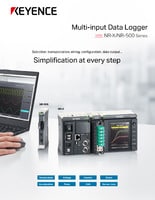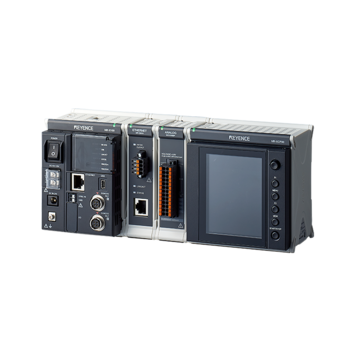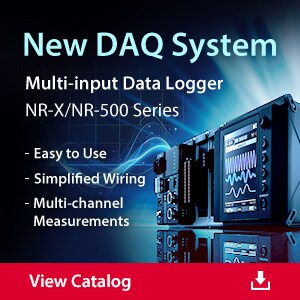Data Acquisition (DAQ)
What is Data Acquisition (DAQ)?
Modern metrology methods in an industrial setting often involve measuring various metrics and storing them as retrievable data for further observation and analysis, and that’s where Data Acquisition, abbreviated as DAQ, comes in.
In this article, we’ll discuss what Data Acquisition and Data Acquisition Systems are, what those systems measure, and their importance in the modern-day industry.
So, what is DAQ? Though many believe that DAQs are devices used to conduct data acquisition—and such devices are often referred to as DAQs—Data Acquisition refers to a process of sampling signals that measure real-world physical properties and convert time into a digital form, which is then stored for further analysis.
As such, data acquisition differs from previous, earlier forms of collecting data, such as recording to tape recorders or paper charts. Though it serves the same purpose as previously mentioned data acquisition methods—which relied on analog signals—modern data acquisition converts analog signals into digital and stores them on a digital medium (e.g., ROM memory or flash media).
We’re here to provide you with more details.
Reach out today!

What is a Data Acquisition System?
In technical terms, a data acquisition system, or a DAQ system, is any equipment used to record or document readings or data in a manner that allows data storage and subsequent data retrieval for later analysis.
In other words, a data acquisition system is comprised of measurement devices, analog and digital sensors, a computing unit, and data acquisition software. DAQ systems are used for reading, processing, storing, and visualizing data. They take the readings of a particular sensor and convert it into a legible data set, which is then stored for further analysis.
Due to their sheer practicality, DAQ systems are widely used in many fields, such as manufacturing, automotive, aerospace, environmental monitoring, medical equipment, and scientific research. However, it’s also worth noting that not all DAQs are made equal; individual systems are designed to measure and store different data, and their application ultimately affects the system structure.
We’re here to provide you with more details.
Reach out today!

What Does a Data Acquisition System Measure?
Data acquisition systems can be designed to measure a wide variety of physical and electrical properties, and the specific parameters that are measured depend on the system structure, as well as the nature of the application in which such systems are used. Here’s a full list of common measurements that are monitored and recorded by DAQ systems:
- Current – Electrical current is one of the most common measurements, especially in electrical engineering applications. Many sensors have a current output ranging from 0.4mA to 20mA.
- Voltage – If you add a shunt resistor to an electrical current measurement, you can measure voltage, ranging from millivolts to hundreds of volts.
- Temperature – DAQs can measure temperature using thermocouples, thermistors, and semiconductor-based sensors—such as the infrared sensor.
- Pressure – With adequate sensors and measuring units, data acquisition systems can measure different types of pressure. This includes atmospheric pressure, hydraulic pressure, pneumatic pressure, etc. The computing unit can display these values in different units, including Pascals, PSI, bar, etc.
- Strain and Force – Using strain gauges, data acquisition systems can measure the deformation or strain of particular materials, which is directly related to the force that is applied.
- Displacement – Displacement sensors measure the movement of an object. Based on the movement of a particular object, the data acquisition systems can detect the changes in distance, which can be used to derive the surface topology of an object.
These are just some of the common measurements DAQs can measure, and many systems often include multiple channels, which allows them to measure several parameters simultaneously or a single parameter from different points.
The recorded data is then processed, logged, and analyzed. DAQs can be configured to trigger other processes or control systems based on input data, which makes them invaluable in Supervisory Control and Data Acquisition (SCADA) systems across a multitude of domains.
Discover more about this product.
Click here to book your demo.

Importance of Data Acquisition Systems
Data acquisition systems are essential in monitoring various processes in nearly all fields of modern industry, from research and development to manufacturing, automation, storage, quality assurance, compliance with industry standards, and much more.
Before the advent of data acquisition and DAQ systems, products were often tested in an unstructured and often highly subjective manner. This worked for some industries but not for others, and a perfect example of this would be the testing of a new suspension system in a car. Engineers would often rely on the opinion of test drivers and how the suspension felt to them.
Well, with the advancement of metrology, especially data acquisition systems, subjective feeling can now be quantified through a variety of different sensors and turned into objective measurements. Quantified measurements are easier to repeat, compare, and mathematically analyze compared to subjective feel.
Nowadays, no one would imagine manufacturing any electromechanical device without integrating data acquisition systems into their manufacturing and testing process due to the reliability and safety of DAQ systems.
Curious about our pricing?
Click here to find out more.

Components of the Data Acquisition System
As stated above, each data acquisition system is different, and the structure of a DAQ system largely depends on the process and measurement it’s chosen for. However, the basic structure of DAQ is identical across all systems:
- Transducers – Transducers are devices, such as sensors, that capture the value of a measured physical or electrical property of an object. In the vast majority of cases, these signals are converted into electrical signals that are then sent to signal converters.
- Signal Converters – Most transducers input either an analog or a digital signal. In either case, the signal needs to be conditioned to remove any noise and further processed and converted into a digital signal.
- Computing Unit – The conditioned and converted signals are further stored inside the computing unit to have high-order computations performed and observations made. In other words, this is where the data is collected, saved, and transformed into a readable medium, depending on the requirements.
We’re here to provide you with more details.
Reach out today!

The Measurement Process
The measurement process is quite simple: a transducer picks up a value of a physical phenomenon and converts it—in most cases—into a measurable analog electrical signal.
This signal is fed into converters, which sample the analog signals at discrete rates and convert them into digital ones. This signal is then written in a time-based stream to memory media for further analysis.
We’re here to provide you with more details.
Reach out today!

Summary
Data acquisition systems are incredibly useful, as they allow you to measure physical phenomena associated with nearly any operation whose process can be quantified, regardless of its complexity.
Discover more about this product.
Click here to book your demo.




